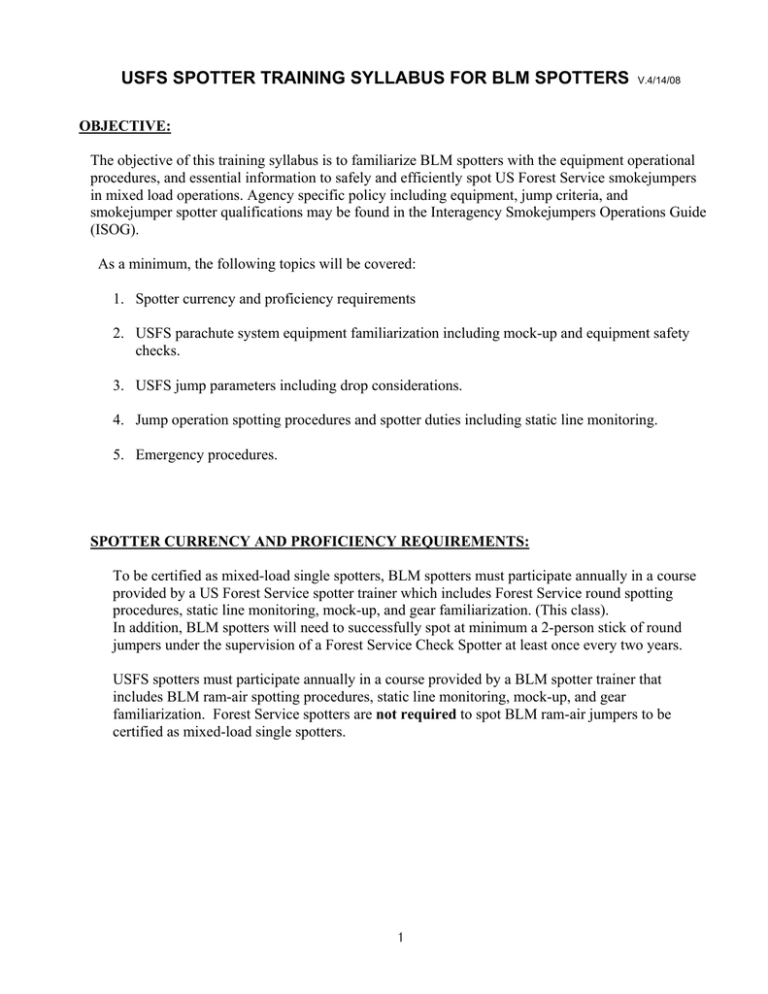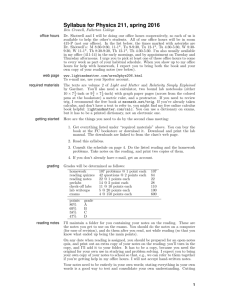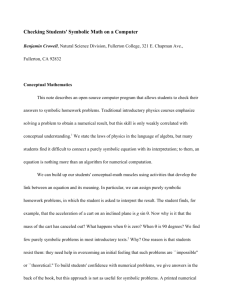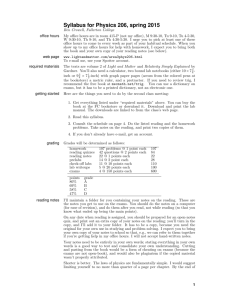USFS SPOTTER TRAINING SYLLABUS FOR BLM SPOTTERS
advertisement

USFS SPOTTER TRAINING SYLLABUS FOR BLM SPOTTERS V.4/14/08 OBJECTIVE: The objective of this training syllabus is to familiarize BLM spotters with the equipment operational procedures, and essential information to safely and efficiently spot US Forest Service smokejumpers in mixed load operations. Agency specific policy including equipment, jump criteria, and smokejumper spotter qualifications may be found in the Interagency Smokejumpers Operations Guide (ISOG). As a minimum, the following topics will be covered: 1. Spotter currency and proficiency requirements 2. USFS parachute system equipment familiarization including mock-up and equipment safety checks. 3. USFS jump parameters including drop considerations. 4. Jump operation spotting procedures and spotter duties including static line monitoring. 5. Emergency procedures. SPOTTER CURRENCY AND PROFICIENCY REQUIREMENTS: To be certified as mixed-load single spotters, BLM spotters must participate annually in a course provided by a US Forest Service spotter trainer which includes Forest Service round spotting procedures, static line monitoring, mock-up, and gear familiarization. (This class). In addition, BLM spotters will need to successfully spot at minimum a 2-person stick of round jumpers under the supervision of a Forest Service Check Spotter at least once every two years. USFS spotters must participate annually in a course provided by a BLM spotter trainer that includes BLM ram-air spotting procedures, static line monitoring, mock-up, and gear familiarization. Forest Service spotters are not required to spot BLM ram-air jumpers to be certified as mixed-load single spotters. 1 USFS SPOTTER TRAINING SYLLABUS FOR BLM SPOTTERS V.4/14/08 USFS PARACHUTE SYSTEM EQUIPMENT FAMILIARIZATION: H-5 Harness assembly with capewell fittings. Harness: Main Canopy: FS-14 ο Static line operated backpack ο Polyconical canopy available in three canopy sizes o Small: 28’ diameter- recommended exit weight range@ 5000’ and 85 degrees: 180>225 lbs. o Medium: 30’ diameter recommended exit weight range@ 5000’ and 85 degrees: 225>255 lbs. o Large: 32’ diameter recommended exit weight range@ 5000’ and 85 degrees: 255->285 lbs. o Size ranges vary with density altitude. It’s common to jump one size but spotter should question a jumper bumping two sizes. ο Riser and chest strap on harness is color-coded. o Small is blue, medium is olive drab, large is gold. ο ο ο Average airspeed at full run: 9 to 11 mph. Average rate of descent: 15 ft/sec Turn rate at full toggle throw: 360 degrees in 4 to 5 seconds. o Capable of reverse flight at 2 to 3 mph. FS-14R Reserve Canopy: ο 26’ conical emergency canopy with vent steering system and soft toggles. ο Center pull activated, manually deployed chest pack with pilot chute. Ankle Braces & Reserve Knife: ο Aircast over the boot ankle braces are required on all parachute jumps. The braces come in three sizes, small, medium, & large. ο Jack the Ripper hook knife located on top of reserve chest pack. 2 USFS SPOTTER TRAINING SYLLABUS FOR BLM SPOTTERS V.4/14/08 “Mock up” with Equipment Checks: Even though BLM spotters will not be doing equipment checks, a full “mock- up” demonstration of this procedure and a break down demonstration of the deployment sequence of each canopy will help with equipment familiarization. Each USFS Smokejumper will receive a pre-jump equipment check by a qualified USFS Smokejumper prior to boarding the aircraft. The spotter will verify the completion of this check. Any jumper may request that safety checks be done by a qualified USFS Spotter in addition to a safety check done by a jumper. The Pre-jump Equipment Safety Check or “buddy check” includes: ο ο ο ο ο ο ο ο ο ο ο ο ο ο ο ο Boots and ankle braces – on & snug? Stirrups under insteps & adjustment ends on suit correctly buckled, no loose ends? Leg pockets securely closed and cord ends stowed, letdown rope in leg pocket? Jump suit zippers secured and working properly? Harness leg straps twist free, snaps cleanly secured to V-ring, excess strap stowed? O-rings with locking carabineer for letdowns? PG bag attachments – straps cleared & fastex not broken? Reserve attached properly, seal & pin check, handle secure, date checked, knife checked? Pack tray belt fastened & snug? Chest Strap on Harness correctly routed through buckle & secured? Capewells seated properly. (Ears, slider, release cable, cover)? Jacket collar up and clear, zipper works, fire shirt on? Risers straight & clear to main parachute (check canopy size & verify with jumper)? Harness on correctly, check shoulder straps, and look for “X” on back? Main parachute back tray closed properly? Static line routed correctly through break tape, rubber band stows, over left shoulder is stowed correctly with a functioning static line clip and safety pin. (Newer double action clips will not have a safety pin). ο Check for PG bag, helmet, gloves, radio, letdown rope, and other appropriate gear (packout bag, fire shelter, PPE, wind indicator, etc.) ο Inspection sequence should not be interrupted, if distracted, begin again. ο If a problem is found and can be immediately corrected, the sequence may be restarted at the sequence step that preceded the one uncovering the problem. 3 USFS SPOTTER TRAINING SYLLABUS FOR BLM SPOTTERS V.4/14/08 USFS JUMP PARAMETERS AND DROP CONSIDERATIONS: During jump operations, jump / no jump decisions will be up to the judgment of the spotter. If the spotter feels uncomfortable with the jump conditions, back off to a larger spot, consider landing at a nearby airport and arranging alternative transportation, or dry run the fire. All jumpers also retain the right to turn down a jump assignment if they feel it is unsafe. Jump Parameters: ο Only SASEB (Smokejumper Aircraft Screening & Evaluation Board) approved aircraft may be used for dropping smokejumpers. ο Minimum Drop altitude for USFS Jumpers is 1,500’ AGL over the exit point. Be aware of rising terrain. ο Standard 20’ drift streamers of traveling 500 yards equals about 15 mph (with 75 seconds on streamers). This is a “red flag” for dropping rounds and dependant on quality of jump spot, jumper experience, and the wind profile, especially the ground winds. ο Winds in excess of 12 mph should be approached with caution. Again, jump spot and Jumper experience are critical factors to consider. ο Wind cones for jumpers on FS-14 canopies are considerably smaller and the glide slope is steeper. Ratio is about 1.2: 1. Drop considerations: ο The wind line and getting the jumpers out over the specific exit point is more critical. ο Vertical separation is very limited. Consider single person sticks in tight spots or spots with only one approach ο With 2-person sticks, imaginary middle jumper exits directly over exit point. ο In challenging jump spots, consider bumping up a more experienced jumper. ο With 2 to 3 mph reverse flight characteristics, jumpers may face the spot more and use reverse, which from spotters standpoint, may look like they are running all the way and may not necessarily be the case. ο Malfunctions are very infrequent with the FS-14 but most often include broken steering lines or slow opening canopies. ο On all jumps, communicate well and wait for the first jumper to radio up information about jump conditions. 4 USFS SPOTTER TRAINING SYLLABUS FOR BLM SPOTTERS V.4/14/08 Jump Spot Considerations: ο Use a conservative approach, (larger spot nearby), and consider size, hazards, safety zones alleyways and access. Basically no different than with ram airs with a few exceptions: ο Alternate spots need to be in closer proximity to the jump spot and the wind line than with ram airs since the FS-14 canopy cannot cover as much ground and spends less time in the air. ο Steep approach spots are not as much of a problem, but be cautious of vegetation-induced turbulence. ο Topographical feature and funnel winds, which cause turbulence, should be avoided. ο Ridge top winds may be too strong, leaving no safety margin from going lee side. ο Low passes and single sticks are encouraged. JUMP OPERATION SPOTTING PROCEDURES, AND SPOTTER DUTIES: Both agencies jump operation procedures and spotting duties are similar. Some points to highlight include: ο When smokejumpers from one agency arrive at another agency’s base, the receiving base will be responsible for conducting a refresher on mixed load operations with all available spotters and pilots. Include review or familiarization with aircraft, radios, and paracargo ops. ο Each jumper shall have a pre-jump safety equipment check by a qualified spotter or a qualified jumper. The mission spotter has the responsibility to ensure that this check has been performed prior to boarding the aircraft. ο The spotter needs to check routing and monitor static lines from each jumpers parachute container to secure attachment on the appropriate cable. When jumpers exit small door aircraft, spotter monitors static lines to door edge, insuring clear path for next jumper. In large door aircraft assistant spotter actually guides each static line to the door edge, releases it and guides the next. DEMONSTRATE with static line and D-Bags. (This may also be done during the equipment mock-up). 5 USFS SPOTTER TRAINING SYLLABUS FOR BLM SPOTTERS V.4/14/08 Jump Operation Spotting Procedures: ο Duel agency spotting of mixed loads is not required but may be advantageous in order to qualify BLM spotters during a boost or provide expertise and input into spotting decisions for their respective systems. The spotter representing the home base will be the spotter-in-charge unless otherwise agreed upon by the host base. ο Load configuration may be adjusted to for efficiency. It is usually most efficient to drop USFS jumpers “rounds” before the BLM jumpers “Squares”. Exceptions may be necessary when conditions warrant and the mission coordinator if operating with two spotters will make the determination of the jump order. It is advantageous to sort this out as early as possible. ο As with both agencies, helmets, gloves, fastened seatbelts, and secured PG bags are required for take-offs, landings, and cargo drops. ο Notify jumpers ten minutes out from fire to allow time for personal equipment readiness and situation awareness. ο A low observation pass is over the incident is recommended for identification of hazards, lowlevel turbulence, fire information, access, safety zones, and escape routes. ο Standard streamer drops are timed using 20’ drift streamers from 1,500’ AGL. Again, for dropping round jumpers, winds in excess of 12 mph should be approached with caution and 500 yards of drift is always a “red flag” and the spotter must weigh all factors and exercise sound judgment. Clear and open communication with jumpers is important. Wind line and exit point are more critical to round jumpers, and we all are cautious of possible down air. ο All spotters use the “INTERAGENCY SPOTTER COMMANDS JUMP DOOR CHECKLIST”. REVIEW the checklist at this point. (See attached). ο Two person sticks are the recommended standard size. Single sticks are accepted and at times, highly recommended. Standard stick size for USFS smokejumpers is a 2-person stick for training and operational jumps. Exceptions allow a 3-person stick to be used from large door aircraft that allow a standing exit when conditions are favorable. ο Obtain jump condition input back from USFS jumpers on the ground prior to dropping 2nd stick of jumpers. ο Jumpship altitude transitions either up or down should allow both the pilot and the spotter to monitor any jumpers still in the air and stay oriented with the jump spot. This is usually best accomplished with a comfortable orbit around the spot versus a long “out and back” leg. 6 USFS SPOTTER TRAINING SYLLABUS FOR BLM SPOTTERS V.4/14/08 Spotter Duties: Pre- Taxi: ο ο ο ο ο Ensure proper number of jumpers is on board, seated, and belted. Check that ramp, APU, etc. are clear. Door strap or in-flight door properly secured. Establish commo with cockpit and inform ready to taxi. Observe sterile cockpit for take-off and climb out. Monitor radio traffic. Enroute: ο Provide info to jumpers, especially JIC. Have them on second commo station in back if possible. Give a heads up 10 minutes out. ο Issue any base specific items, i.e. GPS, cell phones, camera, etc. Record property numbers if applicable. ο Issue map, resource order, radio frequencies and contact info, etc. ο Make sure 2nd jumper has a wind indicator. Most all carry one. Over Incident: ο If possible, coordinate with pilot and jumper(s) in discussing jump spot selection, alternatives, hazards, patterns and altitude. ο Discuss current and expected fire behavior, LCES, resources need, additional air support, road access, water sources, equipment needs, and IC qualifications if applicable. ο Wait for assistant spotter to come back prior to beginning drop operations (Large door aircraft) ο During jumper briefings and post hook-up, visually inspect each jumper for equipment problems or irregularities. ο Post hook-up, check static line clip, check and monitor static line for misroute and inform jumper(s) they are clear. ο Follow the Interagency Spotter Commands Jump Door Check list (see attached), which should be posted by the exit door of all smokejumper aircraft. Only the first jumper of each USFS stick receives a slap, the others will follow. (Approximately a 2 second cadence from “Get Ready” to the exit of 1st and then exit of second round jumper.) ο Upon exit, guide static line to door edge, release and guide next static line. (Discuss 3-person stick monitoring). ο Check to see if jumpers are clear of the aircraft (not in tow). ο Retrieve static lines and D-bags (there will be a bit more resistance with round D-bags that with ram air static line retrieval), unhook from cable and stow. Next stick of jumpers should not hook up until told to. ο Secure strap across door after retrieving d-bags from last stick of jumpers. 7 USFS SPOTTER TRAINING SYLLABUS FOR BLM SPOTTERS V.4/14/08 Paracargo: ο Pre-operational briefing and CRM is critical. Assistant is usually the cargo hauler. Spotter gets rear of A/C set up for cargo while asst. spotter gets cargo. ο Asst. spotter helps kick cargo. Know the cadence and signal for kicking. ο Spotter normally retrieves d-bags ο Make sure spotters (you) are tethered. ο Use caution around a roller track and never leave cargo unattended sitting on the roller track. ο Post cargo, clean up the rear of the aircraft, secure roller track secure remaining cargo, and get ready for next mission. Post Mission: ο Make the time to do a good debriefing with all crewmembers. ο Complete any paper work and ensure readiness for next mission. EMERGENCY PROCEDURES: Standard procedures for emergency exits documented in the Interagency Smokejumper Training Guide will be used for emergency exits with all parachute systems. ο The pilot is the primary authority in matters pertaining to the aircraft’s condition and the necessity for an emergency exit. ο Spotter maintains positive control during an emergency and does everything he can to insure all jumpers get out of the aircraft safely. ο If jumpers are wearing main parachutes when the pilot or spotter orders an exit, the jumpers shall use the designated emergency cable. Before initiating the emergency exit, the spotter must be certain that the aircraft is high enough for a parachute to open. 500’ AGL is the minimum altitude for reliable main or reserve deployment. ο Jumpers shall jump with their emergency parachute when it is impractical to hook their static lines to the emergency cable, or if they are not equipped with backpack parachutes. ο Jumper in tow uses standard signals. Jumper has both hands on helmet looking at reserve handle and is prepared to be cut away. Spotter maintains communication with pilot and may either retrieve jumper or cut jumper away. 8 USFS SPOTTER TRAINING SYLLABUS FOR BLM SPOTTERS QUESTIONS? 9 V.4/14/08 USFS SPOTTER TRAINING SYLLABUS FOR BLM SPOTTERS V.4/14/08 INTERAGENCY SPOTTER COMMANDS JUMP DOOR CHECKLIST The spotter in charge of each mission should be clearly identified. Note: When dropping ram-airs, spotter should request from pilot any noticeable wind changes at 3,000’ AGL, prior to dropping ram-airs. Adjust exit point accordingly. Although rarely necessary, streamers thrown from 3,000’ AGL are always an option. Spotter signals to the jumpers the number in the stick. 1. “ARE YOU READY?” & “LEG STRAPS TIGHT?” These two questions are asked of the jumper in the first stick, who then answers for the entire stick. Being ready means you have been checked, PG bag is hooked up, and helmet is on. 2. “HOOK UP” This command is given to the entire stick. Round jumpers hook-up to the appropriate cable (vertical/horizontal/floor). Ram-airs hook to appropriate extender handed them by the spotter. PRE-JUMP BRIEFING: Pre-jump briefing should include as a minimum: jump spot confirmation, jump spot hazard identification (if any), estimated streamer drift and windline, type of drop pattern, jump spot elevation, and pertinent wind info at 3,000’ AGL (ram-airs only). End briefing by asking “ANY QUESTIONS?” 3. “WE ARE AT 3,000 FEET, ACTIVATE YOUR AAD” This command is for ram-air jumpers only and will always be given prior to the jumper getting in the door. This command prompts ram-air jumpers to activate their cypress AADs. (Before giving this command, the spotter will confirm with the pilot that the aircraft has leveled off at 3,000 feet AGL.) 4.“GET IN THE DOOR” This command given before or after pre-jump briefing, to the first jumper in the stick. This command also prompts ram-air jumper’s 4-point check. All ram-air exits will be sitting. Round exits will be using the step or standing, depending on the aircraft type. 5. “TURNING FINAL 1500’/3000’, STATIC LINES CLEAR” Confirmation given so that each jumper in the stick can hear. The spotter may have notified the jumper that their static line is clear previously, but this is a final check. 6. “ Get Ready” Command given just prior to slapping first jumper out the door. ROUNDS: Slap only the first jumper in the stick. SQUARES: Slap each jumper, spacing jumpers a minimum three seconds apart. Exiting square jumpers static lines can be effectively cleared for following jumpers in the stick by sliding it towards the upper left corner of the door, after the drogue has deployed from the D-bag. 10







